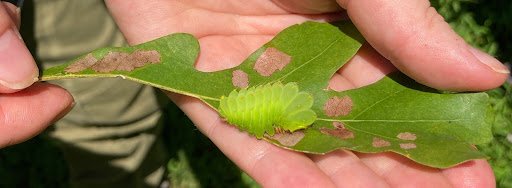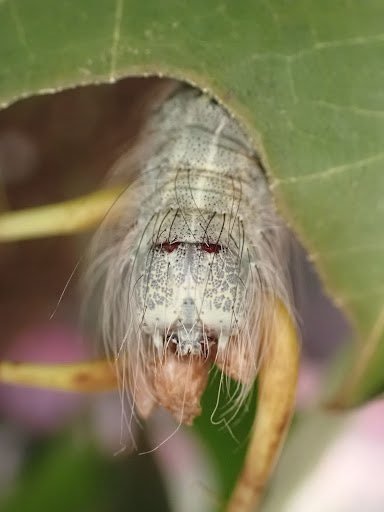The Mid-Atlantic winter season is now in full swing - at least, according to the calendar. This means the Burghardt lab is in the depths of data analysis for last summer’s projects. Seeing the results of our field season come together is very exciting, but it does make us sentimental for some of the fascinating Lepidoptera we found during data collection. While each caterpillar we find munching away on the tree leaves is something special, every so often a discovery is met with particular excitement (and a quick little photoshoot) from the samplers. The following are a few of the species that really captured our attention last summer.
Spun Glass Slug Moth
Scientific name: Isochaetes beutenmeulleri
Insect Family: Limacodidae
Host Plants: Normally beech and oak trees. We have found them on oaks (Quercus spp.) and sycamore (Platanus occidentalis)
Image description: Late instar I. beutenmuelleri, collected from SERC BiodiversiTREE field site, Aug 2022. Photo credit: Eva Perry & Kelsey McGurrin
Photos rarely do this caterpillar justice! Spun glass slug caterpillars are one of the more fantastical caterpillars that can be found in the Mid-Atlantic. As their common name suggests, these ethereally translucent caterpillars resemble remarkably delicate little pieces of spun glass, an appearance more akin to ocean-dwelling nudibranchs than to many other caterpillars found in eastern North America. This caterpillar’s range spans from southeastern New York to Florida, and as far west as Missouri, eating oak and beech tree leaves in deciduous woodland before shedding their protective tentacle-like lobes and building a cocoon. This species, like many other hairy or fuzzy caterpillars, falls firmly in the “look, but don’t touch” category – their lobes are covered in hundreds of tiny spines that pack a seriously painful and long-lasting sting!
Polyphemus Moth
Scientific name: Antheraea polyphemus
Insect Family: Saturniidae
Host plants: Many shrubs and trees. We have found them on oaks (Quercus spp.) and ironwood (Carpinus caroliniana)
Image description: Middle (top) and late (bottom left and right) instar A. polyphemus, collected from SERC BiodiversiTREE field site, summer 2022. Photo credit: Eva Perry & Karin Burghardt.
Named for the giant cyclops Odysseus encounters along the course of his decade-long voyage home, the Polyphemus moth caterpillar is a striking green behemoth that can reach a length of over seven centimeters in its final instar. The Polyphemus moth is found nearly everywhere on the North American continent excluding Nevada, Arizona, and the far north. This species eats the leaves of a variety of woody plants and trees, including ash, elm, and oak trees. A member of the giant silk moth family (Saturniidae), the Polyphemus caterpillar constructs a finely-spun cocoon within which to pupate, often in the leaf litter below its host tree. Like many other Lepidoptera species, Polyphemus moth caterpillars will sometimes “clip” the leaves they are eating. This means that once they have eaten the leaf, they will chew through the petiole, letting the leaf remnants drop to the ground, which may suppress plant defenses through chemicals in the caterpillar’s saliva (Dussourd 2022).
Question Mark Butterfly
Scientific name: Polygonia interrogationis
Insect Family: Nymphalidae
Host plants: Elm, hackberry, hops, and nettles. We have found them on elm (Ulmus americana)
Image description: P. interrogationis early (top) and late (bottom left and right) instars, collected from SERC BiodiversiTREE field site, summer 2022. Photo credit: Eva Perry & Kelsey McGurrin
One of the few species of butterfly we encounter on the trees we sample, the “question mark” caterpillar (named for wing patterns on the adults that look like question marks) can be found from southern Canada to central Mexico and Florida. These caterpillars’ spines can vary in color, most commonly orange and red, but can sometimes be yellow or black. Question mark caterpillars can most frequently be found eating elm, but sometimes will eat hackberry, hops, and nettles. We usually find them feeding in groups, especially as early instars. Unlike many of the species we find at BiodiversiTREE (which overwinter in their pupae), members of the Polygonia genus – including the question mark butterfly – overwinter as adults, some individuals even migrating southwards before winter.
Laurel Sphinx Moth
Scientific name: Sphinx kalmiae
Insect Family: Sphingidae
Host plants: Ash, fringe-tree, privet, and other plants in the olive family. We have found them on green ash (Fraxinus pennsylvanica)
Image description: Early (top left), middle (top right), and late (bottom) instar S. kalmiae, collected from SERC BiodiversiTREE field site, June 2022. Photo credit: Eva Perry & Kelsey McGurrin
Despite its common name, the Laurel sphinx moth caterpillar can most frequently be found on plants in the olive family (Oleaceae), such as lilac and ash, across eastern and central North America. Their most striking feature is perhaps its blue and black horn on the eighth abdominal segment – the horn is a common feature among many hawkmoth caterpillars (often aptly called “hornworms”), but this color and patterning is unique to the Laurel sphinx. When we first found this particular individual, it was only a couple of centimeters long and had no unique markings. Several species of sphinx caterpillars can feed on ash trees, so in order to identify it we reared it in the lab until distinguishable features developed. Laurel sphinx caterpillars can grow to an impressive length of eight centimeters before spinning their cocoons and pupating.
Greater Oak Dagger Moth
Scientific name: Acronicta lobeliae
Insect Family: Noctuidae (subfamily Acronictinae)
Host plants: Oaks (Quercus spp.)
Image description: Early (top left), middle (bottom left), and late (right) instar A. lobeliae, collected from SERC BiodiversiTREE field site, summer 2022. Photo credit: Kelsey McGurrin
This fuzzy little oak specialist can be found in woodlands and forests of North America’s eastern coast, from Canada to Florida. The greater oak dagger moth is of some interest because of its two distinct regional larval color schemes. In Maryland, the caterpillars closely resemble the image above: light gray with a creamy white dorsal stripe, and deep red patches on the top of the head surrounded by gray speckling. This contrasts with caterpillars of what is presumed to be the same species further north, whose coloring is much darker and lacks the red patches on the head capsule. The position of the hairs on the greater oak dagger moth’s caterpillar make for excellent camouflage on bark and branches, giving the caterpillar a flattened appearance that is difficult to distinguish from its background. This was another caterpillar that we needed to rear in order to identify it to species. There are approximately 40 species of Acronicta in our area, many of which feed on oak, and (as mentioned above) their appearances as caterpillars can vary a lot. Thankfully this one survived in lab long enough to develop some distinguishing features!
Sources
Beadle D & Leckie S, 2012. Peterson field guide to moths of Northeastern North America. Houghton Mifflin Harcourt, New York, New York, USA.
Dussourd D, 2022. Salivary surprise: Symmerista caterpillars anoint petioles with red saliva after clipping leaves. PLoS ONE 17(3): e0265490. DOI: 10.1371/journal.pone.0265490.
Wagner DL, 2005. Caterpillars of Eastern North America: A Guide to identification and natural history. Princeton University Press, Princeton, New Jersey, USA.
Written by Eva Perry and Kelsey McGurrin













